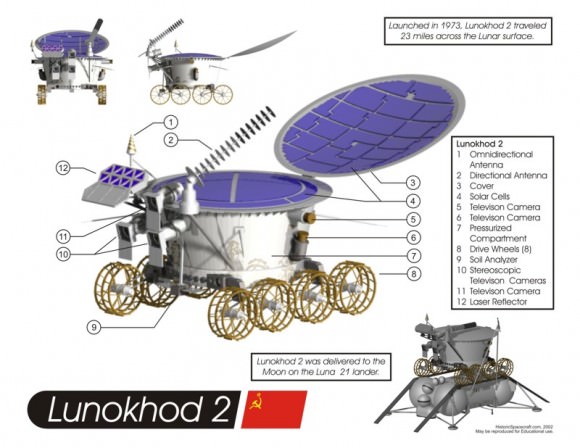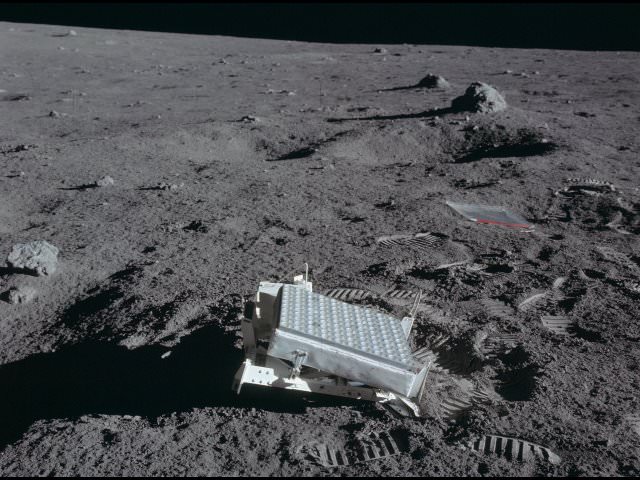Representing what may be the first long term lunar environmental impact study, recent laser ranging data from the Apache Point Observatory in New Mexico suggests the Lunar Ranging Retro Reflectors (LRRRs) left on the Moon by Apollo missions 11, 14 and 15 are beginning to shows signs of age.
Apache Point Observatory’s Lunar Laser-ranging Operation (the acronym says it all) has been collecting ranging data from the LRRRs since 2006, using a 3.5 metre telescope and a 532 nm laser.
A typical APOLLO observing session involves shooting the laser at the largest of the LRRRs (Apollo 15’s) over a ‘run’ of four to eight minutes. Each shot sends about 1017 photons to the Moon, from which only one returned photon per shot may be detected. This is why the laser is shot thousands of times at a 20 Hz repetition rate during each run.
If the return signal from the Apollo 15 LRRR is good, the laser is then directed to fire at the Apollo 11 and 14 reflectors. The laser can even be directed to the Russian Lunokhod 2 reflector, landed on the Moon in 1973, although this reflector does not return a reliable signal if it is in sunlight, probably because heating affects the reflectors’ refractive index and distorts the return signal.

The Apollo LRRRs were designed to remain isothermal, even in direct sunlight, to avoid the problem apparently suffered by Lunokhod 2. But a review of current and historical data has revealed a noticeable decline in their performance at each Full Moon. Since the reflectors are directed straight at Earth, they experience the most direct sunlight at a Full Moon.
Recent Apache Point Observatory data has been compared to historical data collected by earlier observatories involved in lunar laser ranging. For the period 1973 to 1976, no Full Moon deficit was apparent in data records, but it began to emerge clearly in a 1979 to 1984 data set. The research team estimate that return signal efficiency at Full Moon has degraded by a factor of 15 over the approximately forty years since the Apollo reflectors were placed on the Moon.
While heating effects may play a part in the performance degradation of the LRRRs, lunar dust is suggested to be the more likely candidate, as this would be consistent with the very gradual performance degradation – and where the most substantial performance loss occurs right on Full Moon. These findings may require careful consideration when designing future optical devices that are intended to remain on the lunar surface for long periods.
On the bright side – all the reflectors, including Lunokhod 2’s, are still functioning on some level. Hopefully, decades before their slow and steady decline progresses to complete failure, even more efficient replacement devices will be landed on the lunar surface – perhaps carefully positioned by a gloved hand or otherwise by robotic means.
This article was developed from this very readable scientific paper.


Well. We better go there and replace them!
We can’t. Mr. Obama is the President.
Call up the Russians.They’ll have to do it.
No, the Chinese will be the next ones up there. We’ll have to hand them the reflector and ask nicely if they can hand place that in a good spot.
A little off topic…..when will we see the Russian Lunokhod rovers from LRO images? Seems they should be easy to spot!
Tedwilym: Actually the LROC team has taken images of the Lunokhods and this has been announced on the LPSC conference.
But the LROC team is famous for sitting on imagery and refusing to release them to the interested parties – or to the public. How pathetic.
Recent evidence of chemosynthesis in surface soils on the Moon, due to ion sputtering, point toward deposition on the surfaces of the reflectors?
So what’s moving the dust?
horrendous said;
So what’s moving the dust?
Electrostatics?
@horrendous
Sunlight make the dust electrically charged so some small parts actualy start to float becaus they repell each other. At moonnight the dust drops down again so slightly differnt location.
It is not much but enough to accumulate over 40 years.
Entropy – it grows on you.
@ I would too predict that most of the dust would result from electrostatic processes.
Obviously the reflector optical surfaces are pointing away from the Moon surface. Sputtering happens, but there need to be collisions for redeposition to happen. The large mean free path for the vacuous [sic!] Moon atmosphere isn’t very supportive of that.
[I don’t have time to estimate that parameter here, but feel free to fill in the gap if you think that it is the larger process. Yes, I know – I’m cheating. Oh, well.]
Btw, I think there may be a misconception here: gas phase reactions are very unlikely (have small cross sections) since the momenta need to be matched. So any chemosynthesis are purely surface based and won’t happen above the reflectors.
Either triggered by the sputtering since the sputtering ion collides and divest its momenta onto many target atoms, at least for higher energies. And/or resulting from the incoming ion being reactive, which in the case of the protonic solar wind is a given.
As for US visiting the Moon, very little can be blamed on Obama. He inherited a space program that was destined for failure due to resource lack – that was the Congress fault. He inherited an economy with a huge debt and set up for a land owner crisis that materialized as expected – that was the previous administrations fault, twice over.
And now he had the audacity to a) initiate a hearing of experts b) accepting the recommendation instead of to the Congress critters that looks to local stat interests. Ironically he is blamed for his sensibility, responsibility and ability to make things happen. Probably because from past experience you don’t expect any of that from a US president.
“stat” – state. My kyboard sms to hav a sticky “” ky. To much coffee splatter from rading hilarious commnts of how this is all Obamas fault,
Torbjorn Larsson OM –
I have no response to that.. 🙂
All I want from Obama is a decent internet connection. He has talked about that but so far it’s just talk. Look at the Verizon ads, “not available in all areas”. I have a WildBlue direct satellite connection which is limited and not very reliable.
The USA is far behind many other countries in internet access.
RE: Sunlight induced electrostatically levitated Lunar dust.
See: Moon Storms; also, check out the links on that page.
@Torbjorn Larsson OM: See the Sept. 23, 2009 article from UT… “Yes, there is water on the Moon” – http://www.universetoday.com/2009/09/23/yes-theres-water-on-the-moon/
The article chats up ion sputtering from the solar wind CREATING water molecules on the lunar surface. Now as to how far water molecules might spread in 1/6 gravity after synthesis we’d have to look at the reflector’s height above the surface, density of the solar wind/ion charge state, expected deposition rate and…
LRRR is not an acronym, just a series of initials.
Blaming the cancellation of the Constellation Program on President Obama is absolutely rediculous. NASA has been on a starvation diet ever since Congress cancelled Apollo 18, Apollo 19 and Apollo 20 in 1969. NASA’s resourse woes go back at least 40 years.
Actually, there is a good bit of initiative currently out there from the government to increase broadband acces through the use of grants. I know ViaSat, the company who just acquired Wild Blue, just got close to a $30 million grant to launch a new satellite that will boost satellite internet speeds to up to 8mbps with no additional costs to customers. So, help is coming
All the speed in the world will not help satellite performance for anything other than downloads, because the latency cannot be fixed.
This might be true, but I know I definatley would not mind an extra 5mbps in download speed. I’m sure something will come along soon that will help with latency.
If rovers or unmanned craft, such as the Lunokhod, are sent to the moon an LRRR could well enough be carried along. There is no need for astronauts to manually deploy this. Further, if this is set on a platform, such as the top of a lunar descent module, this problem with lunar dust could be reduced.
It is a bit mysterious as to where the dust comes from. Electrostatic charge from UV radiation does strike me as the likely cause.
LC